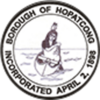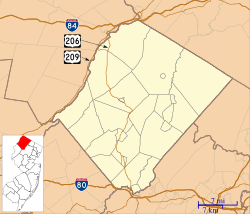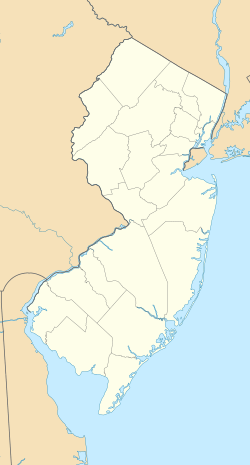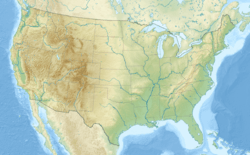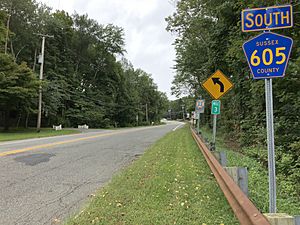Hopatcong, New Jersey facts for kids
Quick facts for kids
Hopatcong, New Jersey
|
||
|---|---|---|
|
Borough
|
||
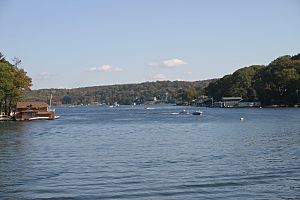
Lake Hopatcong as seen from Hopatcong
|
||
|
||

Map of Hopatcong Borough in Sussex County. Inset: Location of Sussex County in the State of New Jersey.
|
||
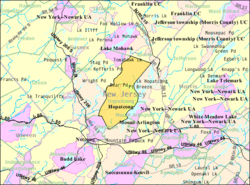
Census Bureau map of Hopatcong, New Jersey
|
||
| Country | ||
| State | ||
| County | ||
| Incorporated | April 2, 1898 as Brooklyn | |
| Renamed | March 22, 1901 as Hopatcong | |
| Government | ||
| • Type | Borough | |
| • Body | Borough Council | |
| Area | ||
| • Total | 12.41 sq mi (32.16 km2) | |
| • Land | 10.88 sq mi (28.19 km2) | |
| • Water | 1.53 sq mi (3.97 km2) 11.83% | |
| Area rank | 186th of 565 in state 16th of 24 in county |
|
| Elevation | 997 ft (304 m) | |
| Population
(2020)
|
||
| • Total | 14,362 | |
| • Estimate
(2023)
|
14,622 | |
| • Rank | 183rd of 565 in state 3rd of 24 in county |
|
| • Density | 1,318.9/sq mi (509.2/km2) | |
| • Density rank | 353rd of 565 in state 6th of 24 in county |
|
| Time zone | UTC−05:00 (Eastern (EST)) | |
| • Summer (DST) | UTC−04:00 (Eastern (EDT)) | |
| ZIP Code |
07843
|
|
| Area code(s) | 973 | |
| FIPS code | 3403732910 | |
| GNIS feature ID | 0885259 | |
Hopatcong is a lovely town, called a borough, located in Sussex County, New Jersey. It's a place known for its beautiful Lake Hopatcong, the biggest lake in New Jersey! In 2020, about 14,362 people lived here.
Contents
History of Hopatcong
The town of Hopatcong has a very interesting past. It's closely connected to New York City.
Early Days and Lake Hopatcong
Hopatcong sits right next to Lake Hopatcong. This lake is partly man-made and is the largest lake in all of New Jersey. Today, it's a popular spot for fun activities and beautiful homes.
Long ago, Hopatcong was a summer escape for rich people from New York City. They came to enjoy the lake, which is about 40 miles west of the city.
Bertrand's Island Amusement Park
There was even an amusement park called "Bertrand's Island" right on the lake! You could get there by boat, trolley, or car through Mount Arlington.
Growth and Development
Later, when Interstate 80 was built, it made it easier to travel. This highway goes all the way from Teaneck, New Jersey, across the country to San Francisco, California. The highway helped Hopatcong grow quickly. It changed from a summer spot to a place where people lived all year round.
How Hopatcong Got Its Name
In the 1800s, the area was first called "Brookland." The big lake was known as "Great Pond" or "Brookland Pond." By the 1830s, the name changed to "Brooklyn," just like the famous city in New York.
Hopatcong officially became a town, or "borough," on April 2, 1898. It was formed from parts of Byram Township. Then, on March 22, 1901, the name changed from Brooklyn to Hopatcong. In 1922, more areas like Byram Cove joined Hopatcong, giving the borough its current shape.
The exact meaning of the name "Hopatcong" isn't fully clear. People say it comes from Native American words. It might mean "stone over water" or "pipestone."
Geography of Hopatcong
Hopatcong is located in Sussex County, New Jersey. It covers an area of about 12.35 square miles (31.99 square kilometers). Most of this area is land, with about 1.46 square miles (3.78 square kilometers) being water.
Neighboring Towns
Hopatcong shares its borders with several other towns. In Sussex County, it borders Byram Township, Sparta Township, and Stanhope. It also borders towns in Morris County, including Jefferson Township, Mount Arlington, and Roxbury Township.
Population of Hopatcong
| Historical population | |||
|---|---|---|---|
| Census | Pop. | %± | |
| 1900 | 75 | — | |
| 1910 | 146 | 94.7% | |
| 1920 | 179 | 22.6% | |
| 1930 | 534 | 198.3% | |
| 1940 | 660 | 23.6% | |
| 1950 | 1,173 | 77.7% | |
| 1960 | 3,391 | 189.1% | |
| 1970 | 9,052 | 166.9% | |
| 1980 | 15,531 | 71.6% | |
| 1990 | 15,586 | 0.4% | |
| 2000 | 15,888 | 1.9% | |
| 2010 | 15,147 | −4.7% | |
| 2020 | 14,362 | −5.2% | |
| 2023 (est.) | 14,622 | −3.5% | |
| Population sources: 1800–1920 1900–1910 1910–1930 1940–2000 2000 2010 2020 |
|||
In 2020, the population of Hopatcong was 14,362 people. This number was a little lower than in 2010, when 15,147 people lived there.
Education in Hopatcong
Students in Hopatcong attend public schools from pre-kindergarten all the way through twelfth grade. These schools are part of the Hopatcong Public Schools district.
Schools in the District
As of the 2020–21 school year, the district had about 1,449 students. There were also 146 teachers, meaning there was about one teacher for every 10 students.
The district has four schools:
- Tulsa Trail Elementary School: This school serves students in pre-kindergarten and first grade.
- Durban Avenue School: Students in second and third grade go to this school.
- Hopatcong Middle School: This school is for students in grades four through seven.
- Hopatcong High School: This is where students in grades eight through twelve attend.
A few years ago, one school, Hudson Maxim School, closed. The grades were then moved to the other four schools.
Transportation in Hopatcong
Hopatcong has many roads that help people get around. Most of these roads are maintained by the town itself. There are also some county roads that pass through the borough.
No major highways like Interstates or U.S. routes go directly through Hopatcong. The main roads are smaller county routes and local streets.
Events and Attractions in Hopatcong
Hopatcong is a lively place with fun events and interesting spots.
Annual Events
The town hosts exciting annual American Power Boat Association (APBA) boat races. These races bring many local residents to the lake for a day of excitement.
Hopatcong is also famous for its yearly "Hopatcong Days." This is a weekend full of activities, including a parade. There are many festivities in Modick Park, sponsored by the local Business Association. These events often include a Soap Box Derby and a Car Show.
Lake Hopatcong Historical Museum
If you want to learn more about the town's past, you can visit the Lake Hopatcong Historical Museum. It has many old items and stories about the area.
Notable People from Hopatcong
Many interesting people have lived in or are connected to Hopatcong:
- Joe Cook (1890–1959): A famous vaudeville actor who lived by Lake Hopatcong.
- Lotta Crabtree (1847–1924): A well-known actress.
- Joe Martinek (born 1989): A top football player in New Jersey high school history.
- Hudson Maxim (1853–1927): An inventor and chemist. One of the local schools was named after him.
- Zach Rey (born 1989): A former wrestler who competed for the United States.
- Dave Yovanovits (born 1981): A former professional football player.
See also
 In Spanish: Hopatcong para niños
In Spanish: Hopatcong para niños


